2016 was an incredible year for drones. Drones – especially those with cameras on them – have given us a new perspective on the world around us (see our review of the best drones). Content creators have been producing HD videos from heights that were only a few years ago only possible if you had a big Hollywood budget.
Today, sweeping skylines and panning overhead shots are commonplace on YouTube. These drones have given rise to exploratory content creators like Casey Neistat and iJustine. They’ve enabled companies like Amazon to explore new methods of delivering packages to customers. This new generation of drones has even firefighters and other first responders a new way to save lives.
Indeed, drones have come a long way in the past year. Consumer-accessible models are coming down in price considerably, and the technologies being used to capture clear, stable shots are finding their ways into the hands of camera operators in the form of small, powered gimbals.
New drone registry requirements kicked off 2016
All of this progress is not without its downsides. 2016 kicked off with new rules from the Federal Aviation Administration (FAA) requiring all drones in the United States between 0.55 and 50 lbs. be registered. This rule is intended to aid in connecting drones that are involved in malicious acts to their operator. These actions include spying in windows, trespassing, interfering with emergency crews, and flying in restricted space.
This registry is not only mandatory, but it comes along with a $5 fee per aircraft. Failure to register an aircraft can result in civil penalties up to $27,500. Criminal penalties for failure to register can include fines of up to $250,000 under 18 U.S.C. 3571 and/or imprisonment up to three years.
Despite this rule being in place, a lot of people flying these little drones remain unaware that it actually exists.
A new crop of camera drones
While a lot of drones hit the consumer market in 2016, one that certainly stood out for its portability and feature set is the DJI Mavic Pro. This drone folds down so small that it can easily fit in a standard purse or small bag. It also captures clear 4k footage with ~21-28 minutes of flight time.
Another highly-anticipated drone to hit the scene in 2016 was the GoPro Karma. This drone paired a great overall flight experience with a handheld powered gimbal that could capture stable footage in the air as well as on land. Unfortunately, over 2,500 units of the GoPro Karma were recalled after units experienced an unexplained power loss in flight.
This power loss (video example above) could result in property damage as well as serious bodily injury as it would fall from the sky.
Amazon makes its first Prime Air delivery
Amazon has officially launched a beta test of its drone delivery service, Prime Air. This beta is small, with only two users in a remote area being serviced by a small fulfillment center with specialized drone-launching capabilities.
These customers can make an order on Amazon and receive their purchased item(s) in less than 30 minutes. Amazon’s plan is to expand this program so that these smaller, specialized fulfillment centers are able to provide quick delivery service to more areas. This would bypass their standard shipping partners, ultimately reducing costs and greatly improving the speed of delivery.
Amazon Prime Air drones are currently only able to deliver small items that weigh 5 lbs. or less.
Drone racing approaches the mainstream
https://www.youtube.com/watch?v=QlLbKClHDxE
What do you get when you combine the drama and speed of Nascar, the quick finger movements of esports, and the look and feel of pod racing from Star Wars: The Phantom Menace? You get the Drone Racing League.
Zipping around corners and through loops at 70 mph, the drones of the Drone Racing League are putting on an impressive show. This new sport, in which pilots wear video goggles and hold controllers, is breaking through to the mainstream.
A new broadcasting deal with ESPN ensures that this league, which had been in stealth mode until this year, has all the tools it needs to become the next big thing in competitive sports.
What’s ahead?
With all the excitement and buzz about consumer drones in 2016, what’s ahead for the next year? Well, what if a drone could help you navigate rush hour traffic? What if your car was followed by its very own drone?
Autonomous vehicles are coming. Companies like Google, Telsa, Uber, and others are actively working on technologies that would help drivers get around without ever having to turn a steering wheel. But, what do you do while you’re sitting in the driver’s seat?
The folks at Local Motors are working on that solution right now. The driver (or passenger, technically) would be able to fly a drone that feeds video information to the car. That drone would help discover and avoid potential traffic jams before they would even be reported to navigation apps like Waze or Google Maps.
As drones become more commonplace, drone insurance for hobbyists and companies that utilize them for commercial purposes will become more commonplace.
We may also see a rise in arrests and/or lawsuits resulting from drone activities. Drones are beginning to move from recreational areas such as parks and lakes to autonomously navigating cities. This means drones flying over private property is also going to become more common. The FAA says that shooting down aircraft of any type is a Federal offense, but what can you do if one is hovering over your backyard… maybe with a camera pointed at your bathroom window?
Drones may also become a form of visual entertainment. Much like fireworks and light shows are today, companies like Intel are finding ways to create brilliant light shows put on by autonomous drones that take flight and perform choreographed shows. Drone shows don’t get shut down during burn bans and can occur several times on a single night.
It’s hard to predict the future for a technology that is evolving as quickly as this one. One thing we can be sure of is that drones are going to keep flying for many years to come.











